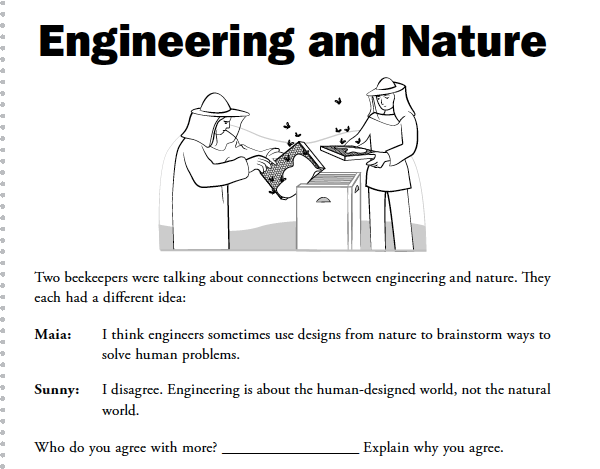formative assessment probes
Uncovering Students’ Ideas About Using Designs From Nature
Scientists seek to understand the natural world, while engineers solve problems in a human-designed world. While there are similarities and differences between the work of scientists and engineers, some students may think the natural world applies only to science. The probe Engineering and Nature (Figure 1) elicits students’ ideas about how nature can provide inspiration and ideas for solving problems (Keeley, Sneider, and Ravel 2020). It reveals whether students recognize that the human-designed world can include designs from the natural world.

Engineering and Nature Probe.
The best answer is Maia’s: “I think engineers sometimes use designs from nature to brainstorm ways to solve human problems.” While Sunny is correct that engineering is about the human-designed world, creative ideas to solving problems can come from natural structures and processes. The beekeeper and honeycomb graphic used in the probe shows how nature solves problems and that can also be applied to human problems. For example, the honeycomb’s six-sided compartment, built by bees, is a strong and efficient way of storing honey. Engineers use the honeycomb structure to design light and strong building materials.
This probe is based on a study conducted with university engineering students. The study found that students were initially reluctant to use natural structures to help them develop solutions. When they did use natural structures, they tended to imitate the structures quite literally rather than using them as inspiration for a source of design ideas. However, when given a short briefing on how to use natural structures as inspirations when thinking about solutions to problems, they were more successful at arriving at creative ideas (Boga-Akyol and Timur-Ogut 2016).
The probe can be used to find out whether students recognize the role that designs in nature can play in solving problems. However, it is best used to activate students’ thinking about how creative ideas about solving problems can come from natural structures and processes and whether their initial ideas mirror the findings from the university study.
After students have had an opportunity to share who they agree with and why, the probe can be extended by showing students a picture of a honeycomb and asking how they might use a structure like the honeycomb as an inspiration to solve a problem or meet a need at home, in their community, or at school.
Do students imitate the structure literally or do they use it for creative inspiration? Have students sketch their ideas and explain them to each other. The probe can be a nice introduction to students learning about bio-inspired designs (also referred to as biomimetics).
Other follow-up activities to further reinforce how designs from nature are used in engineering can include examining familiar bio-inspired designs such as Velcro. Students can also be provided with a collection of real natural objects or photographs of natural objects and processes and come up with ways they can use these designs from nature to solve a human need or problem. The website https://asknature.org/educators provides suggestions for using bio designs in the elementary grades.
This probe, like several others in Uncovering Student Ideas in Engineering and Technology, is less about uncovering students’ misconceptions and more about using ideas they may already have about engineering to activate their thinking and provide opportunities for them to deepen their understanding of engineering design. Ausubel’s (1968) timeless quote also rings true when using formative assessment probes to uncover students’ ideas about engineering design: “The most important factor influencing learning is what the learner already knows and that the job of the teacher is to ascertain this and teach accordingly.” ●
Page Keeley (pagekeeley@gmail.com) is a science education consultant and the author of the Uncovering Student Ideas in Science series (http://uncoveringstudentideas.org).


